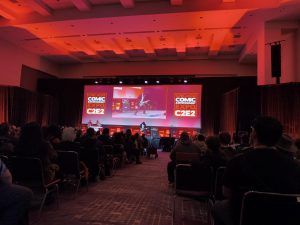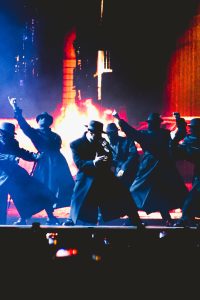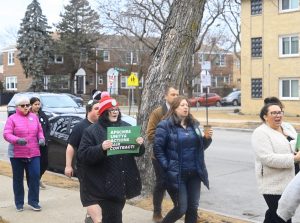Building Bridges in Selma
March 28, 2022

Normally, students use spring break as a time to recharge and regroup for the remainder of the semester. During the week of March 13-20, three groups of students went to three different cities for NEIU’s alternative spring break.
The difference being that an alternative spring break focuses on volunteer work in the places they travel to.
Each group consisted of ten students and two leaders who traveled by plane or car to either Miami, New Orleans or Selma, AL. Here we will focus on the group that went to Selma.
Selma is the birthplace of the civil rights movement of the 1960s. After the passage of the Voting Rights Act of 1964, it was only possible to register to vote on Mondays, and when Black residents went to the courthouse to register, they were met with locked doors, even though the doors for whites only were unlocked.
After James Orange, a Black pastor, was imprisoned for “contributing to the delinquency of minors,” the local white community planned to hang him. A Black janitor inside the jail overheard this plan and informed the rest of the community, which planned to surround the jail, so as to prevent the lynching.
In the succeeding skirmish, Jimmie Lee Jackson, a 27-year-old Black man, was shot in the stomach by police while trying to protect his 82-year-old grandfather from the billy club of a white police officer.
The events of this night were the catalyst for what would come to be known as the March on Montgomery, also known as the Children’s March. This is widely regarded as the beginning of the movement.
The group from NEIU went to learn more about the movement, Selma’s role in it, the current state of the town and what is being done in regards to civil rights. Because, sadly, there is still a need for civil rights advocacy.
After a short delay, the group left the NEIU main campus in two vans on March 13 shortly after 7:00 a.m. on what turned out to be a 16-hour trip.
The first morning had a slight change of plans. Instead of packing boxes of food in a food pantry operated by the Sonlight Ministry, the group worked at the Ministry’s resale shop unloading donated clothes from a semi-trailer that had been sitting for three years — the ideal setting for generations of mice.
Some members of the group were not particularly enthusiastic about this type of work but knew that it was in the best interest of the mission.
After a few hours of work, the group went for lunch and saw the sights around town. Some information was learned from a man carrying a Vote or Die campaign sign that featured a gruesome photo of George Floyd being murdered.
He was stationed outside of a local diner and wore a pair of khakis and a white short-sleeved shirt that were both too big and a tie that was too small. The soles of his dress shoes had started to separate from their toe caps. One student noted that as he held the sign up to a passing car, those in the car shook their heads at what the sign read.
The man informed members of the group of some of the folks running for local positions in Selma, as well as Dallas County, of which Selma is the county seat. He also said that the local population was about 80 percent Black and 16 percent white, yet all the positions of power are held by whites.
This did not occur because of misinformation, he said. All the Black folks knew what issues existed in the town. On the contrary, the white candidates were able to pay off the Black community members that had influence throughout town. Thus once they had power, they were able to hold onto it.
The embodiment of this notion came to fruition shortly after the group visited the National Park Service Interpretive Center right across from the Edmund Pettis bridge that led to Montgomery.
As they were about to cross the bridge, Terry Chestnut, the son of J.L. Chestnut, the first Black attorney in Selma and attorney to MLK and other civil rights leaders, stopped the group and asked if theyt wanted a free tour.
Some members of the group said they did not have a good feeling about Chestnut, who is also a local radio personality. During his speech, the group said he made unsavory comments to some of the members and tried hawking a book his father wrote 30 years prior along with overpriced masks.
The local sheriff came by and Chestnut had nothing but praise for him, but when the group later inquired about the sheriff, the two people they spoke to said he had a bad track record among the Black community and that his campaign slogan was “[He] grin[s] to win.”
The second and third days in Selma involved attending the Selma Center for Nonviolence, Truth and Reconciliation, a center focused on building the Beloved Community that Dr. King and other civil rights leaders hoped would come as a result of their efforts.
According to the Center’s website, the Beloved Community is “a world where the systems and institutions that governed citizens and families were based on love and justice.”
To establish such a community, the Center offers training that focuses on problems at the institutional and cultural levels, as well as the individual level, but stresses that the latter only exists because of the former.
The first day at the Center, the founding executive director Ainka Jackson trained and informed the group on racial equity which explores how the social construct of race was created to divide and conquer people — especially poor whites and people of color.
The goal of the training was to examine how race affects both groups and how we can resist the institutional and cultural forms of oppression in order to unite and build the aforementioned beloved community.
Afterward, Ainka’s mother, Faya Ora Rose Touré—a civil rights activist, lawyer, educator and songwriter—joined the group to sing civil rights songs and help them construct a song of their own.
This song went as follows:
“We were strangers before we came,
But now we are one.
United and vulnerable,
We see each other, hear each other.
It is just a beginning,
Of our coliberation,
To transform this nation,
Share our sorrows, hear our glory.
After lunch, the group went back to the Sonlight Ministry’s food pantry and packed close to 200 boxes of food for local families and elderly members of the community. Some of the food consisted of canned vegetables and soup, plenty of cookies and crackers, nuts, dried fruit and evaporated milk. However, no fresh fruits or vegetables were included.
The second day focused on restorative justice practices that emphasized listening and creating a space, oftentimes in the form of a circle, that allows for people to share and learn from each other. This type of practice is a positive alternative to the traditional forms of punishment, whether that be in school or prison.
The goal of restorative justice is to get to the root of the problem and establish why and how it came to exist. By actively listening, students, administrators, law enforcement and court personnel are able to establish a restorative culture rather than a penalizing one.
Following the restorative justice circle, Linda Blackmon Lowery, a foot soldier in the March to Montgomery, spoke to the group over lunch and explained why the march was also known as the Children’s March.
She said that many parents feared being arrested, which would have resulted in breaking up their families. And so the children came to understand the importance of the march and took it upon themselves to march in place of their parents.
Later, the group visited the National Voting Rights Museum and Institute that Touré helped found and then visited the civil rights monument and historic site across the street from it.
The issue of food insecurity and healthy diets was talked about the following day when the group visited the Mill Village Community Garden & Food Park in Selma, which focuses on improving the overall health of Selma’s population by educating about healthy foods and diets and facilitating access to them.
Drew Glover, the Senior Community Organizer and Development Officer at the Selma Center for Nonviolence Truth and Reconciliation, organized Mill Village with the aim of encouraging healthy eating and showing the impact of local food on the economy.
After a brief introductory lesson and following questions about implementing a community garden at the university, the group got to work weeding a hoop house that grew turnips, okra and kale as well tilling a plot that would be the future site of the “three sisters” of squash, peas and corn.
On the final day of the trip, the group stopped at the Legacy Museum in Montgomery before returning to Chicago. The Legacy Museum features a self-guided tour of the history of how and why the international slave trade began, how it turned into the domestic slave trade, the destruction of generations of families and events post-Civil War, all the way up to the current form of slavery perpetrated by mass incarceration.
Afterward, the group embarked on the 14-hour trip back to Chicago and pulled into the campus lot around 2:30 a.m.
Members of the group encourage any student to consider participating in an alternative spring break in years to come. Jackie Barajas said it is more than just an educational process and that it was more of a open space for everybody to kind of learn more about themselves. She found that everyone she met on the trip shared the same values or the same morals or even the same ideas.









